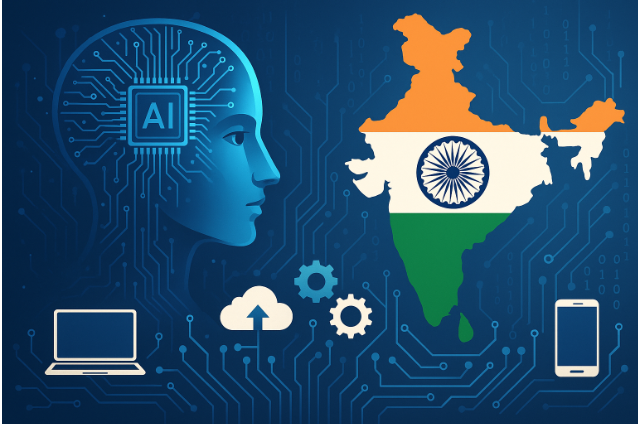
The face of the technological sphere has been completely transformed ever since the revolutionary introduction of Artificial Intelligence. From students to companies, people have been extensively dependent on this onset of technological creation, which seemingly has made things easier for them. Socially and individually, it has gained a fair amount of recent critical attention from everyone concerned with its mass use. Initially, it was limited to an idea of something that is a software tool designed for time management by making problem-solving, decision-making, and understanding easier for humans in this extremely fast-paced world. Instantaneous results were a pressurised demand, and then AI came to the rescue by “mimicking human abilities” better than them, functioning on data and algorithms.
From students to employees, each and every individual has started relying heavily on this mechanised tool for smarter answers and better work results. From schools to companies, the adoption of AI and its incorporation into these professional areas have changed the learning process and work environment drastically. The dependency on this software tool has changed the dynamics of how the work gets done, but also how the human brain works, adapts itself to extreme environments, and the execution of critical thinking skills along with taking responsibility.
Though in the vastness of a rapidly growing sector of the Indian IT (Information Technology) sphere, AI has taken a separate huge and different base, building a new identity for the same. Artificial Intelligence has now become one of the most famous and opportunistically leading courses for IT students. People from different academic backgrounds are now switching to this particular extra course for a faster and better opportunity at fair-paying jobs in the IT hub. Digital education platforms have made this course a profitable business strategy to certify and make their online presence seen as/amongst the education industry.
More than it has been an international phenomenon, it has been massively recorded as a national one. Manual cleaners cannot determine the measures of a room, unlike smart robot vacuums that use this technology to measure the room to clean it more efficiently. The security of houses has been upgraded with the installation of biometric locks that require only need one-time investment. The recent outburst of the AI-generated Ghibli trend was also proof of how it is capable of culturally and artistically modifying an art form. Humans don’t rely on other humanistic companies for suggestions; they go straight to their AI chatbot. Majorly on Instagram, there have been several new artificially generated profiles that incorporate a certain Indian-ness in them. India seems to have become the most comfortable among its international companions in the accommodation of AI in its technological outlook.
According to Nasscom’s data, India’s future economic goals are co-related with the potential maturing of AI in the country, which adds a value of 450-500 billion dollars to the GDP. Its six dimensions include Ethics, Governance and Control, knowledge, operations, investment, strategy and technology. According to Economic Times, India is leading with a 30% AI adoption. It is not only limited to the tech field but also extends towards the banking sector. As per the Deloitte survey data, India acquires a top position in the adoption of Generative AI technology across Asia-Pacific. The Hindu talks about how 98% of organisations in India are using Generative AI tools and training. The Economic Times also states that the five most desired AI skills include development, application, communication, machine learning and strategic leadership. Till February, only 23% of businesses have already implemented the use of AI, while 73% were expected to do so by the end of the year. In a recent IBM article, Sandip Patel, the Managing Director of IBM Idia and South Asia, has said that “The increase in AI Adoption and investments is a good indicator that they are already experiencing the benefits from AI.”
What is clear is the fact that AI exists in everything. Apart from that, it has helped with the prediction of a projected percentage of profit and loss for a new venture or business idea. Medical fields have seen an effective use of AI in determining the extent to which an infection is capable of spreading and in suggesting of successful prevention techniques. For new projects, AI helps in creating a virtual blueprint for a new project. Vision AI generates desired images, Conversational AI shapes a desired conversation, Sense AI deduces human emotions, and Decision AI provides accurate decisions. Perhaps, it has covered almost everything that is required in the field of action and output.
Students in India have made AI their new educator. The dynamics of classroom learning have been transformed. Even teachers have appointed AI to help. They are not interested in learning anymore, rather focus on how they can generate humanised answers from the AI. PPTs are easier to make, being just a command away. Projects do not determine the depth of understanding or creativity anymore. They are now constrained forms of portraying how much talent and creativity have suffered a loss from something that was meant for enhanced power.
The world might be changing with the introduction of AI. But it has challenged the world’s inhabitants by being their alternative. More than it has opened up new jobs, it has taken away older ones. Opportunities from other fields are narrowed down, and futures are at stake with high competition. AI was introduced to make human lives easier, but workers, teachers, employees and artists now feel threatened by its existence on the verge of taking their jobs..
